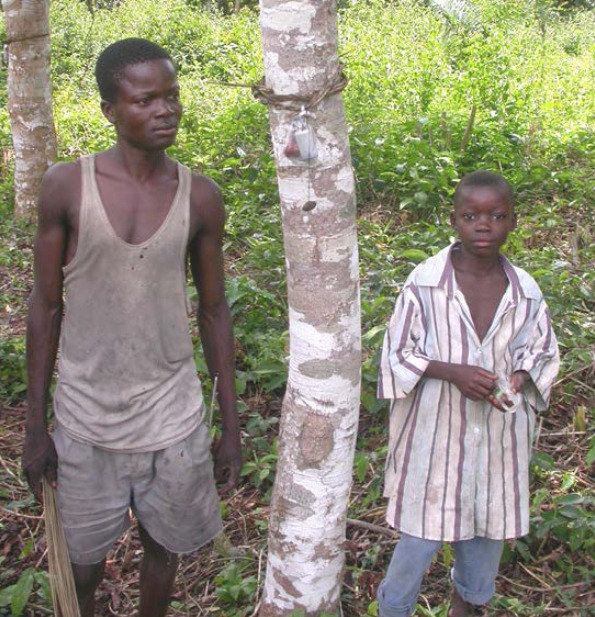Rural families in Kongo Central find it very difficult to get sufficient protein to eat. Hunting has cleared out most of the larger animals and even many of the smaller animals, such as the cane rat, are now difficult to find. Fish and meat are generally far too expensive, and the only other main source of protein is groundnuts. Cassava root and leaf are the staple foods for most rural and city dwellers.


Trees with colonies of caterpillars are often marked either with a cross or with various items hung on the trunk to show that the colony has been claimed by a family and must not be taken. Photos: Paul Latham
Nutritional and commercial value
In Kinshasa, a survey found that 70% of the population ate caterpillars (Monzambe in Balinga et al. 2004). In D. R. Congo as a whole, the consumption of caterpillars is estimated to be 40% of total animal protein consumed. Malaisse & Parent (1980) analyzed the nutritional value of 22 species of edible caterpillar and found the kcal/100 grams dry weight averaged 457 and crude protein content averaged 63.5%.
Quantities harvested from an area of savanna or forest vary greatly from year to year and also according to species and the prevalence of their food plants. It is estimated however that for Cirina forda an amount of 5 kg dry caterpillars can be produced per ha. Mopane worms in southern Africa are gathered and marketed commercially to the value of over 1 million Rand annually and in Malawi yields of 14.63 kg/ha. have been recorded (Munthali & Mughogho 1992). Often sufficient quantities are found during the rainy season for them to be sun-dried and kept for use throughout the year or else transported live to the main markets. Kinshasa, for example, has a section where it is common to find a wide range of species offered for sale. Dried caterpillars can even be purchased in Brussels and London.
Cultural aspects
Caterpillars are considered a luxury food on par with the fruit of the African pear, (Dacryodes edulis) in Kongo Central province. Many of them bear the same Kikongo name as the food tree on which they are most frequently found. Similar names for the caterpillar and the main food plant appear to be used throughout Africa, wherever caterpillars are eaten. Caterpillar species also enter into folklore and are commonly invested with human characteristics. Several proverbs relate to caterpillars and their behavior.
Conservation of species and food plants
Farmers in Kongo Central province practice a traditional system of shifting cultivation allowing the forest fallow to build up soil fertility over several years. Due to increasing population however, the length of fallow has shortened from between 15 to 20 years to sometimes as little as 4 or 5 years, and much of the forest cover and also its ability to recover has been lost. Yet the forest and its by-products, in addition to producing timber, firewood, and charcoal, are of vital importance to the rural population.
The forest produces a variety of wild vegetables and fruits, mushrooms, edible insects, medicinal plants, honey, and tying materials and protects water sources. Any loss of the forest fallow therefore significantly affects the quality of life for large numbers of people. The importance of the forest fallow cannot be over-emphasized because, in large parts of the humid tropics, it still represents the only practical method for replenishing soil fertility (Nye & Greenland 1960).
Conservational factors
It used to be the custom that when two or more generations of caterpillars were known to be produced in a season, the first generation was left to pupate. The first generation of Ngala caterpillars (Cirina forda), for example, were traditionally left “for the birds”. Elsewhere if caterpillars were found on branches of trees too high up for the collectors it was also traditional to leave them there, rather than cut the branch down. Unfortunately, these safeguards are no longer respected in many villages.
There is potential for far greater production of edible caterpillars with minimum additional input of labor. Most edible caterpillars in Kongo Central live on forest trees and thus enhance the value of the traditional forest fallow. It has been shown that the combined output, annually, from beekeeping and the production of edible caterpillars from an area of forest can far exceed the value of the food crop for which the forest was initially cut down! (Munthali & Mughogho 1992).
More articles on this website about caterpillars can be found via the following links:
Edible caterpillars in D.R. Congo, Introduction
Edible caterpillars in D.R. Congo, Part 1
Edible caterpillars in D.R. Congo, Part 2
Edible caterpillars Nudaurelia sp.
Collection of edible caterpillars in D.R. Congo
Stinging nettle slug caterpillar in Vietnam
Green caterpillars, called ‘Kaba’
___________________________________________________________________________________________________________
Text and all photos at this article © Paul Letham. The professional background and contact information of the author of this article can be found here.
.





